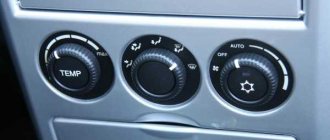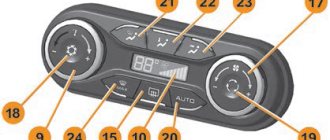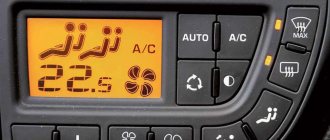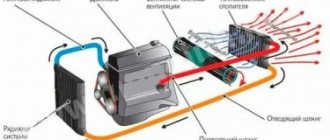From a control point of view, climate control is one of the simplest components of a modern car. The driver just needs to set the desired temperature and set other correction settings if desired, and the car itself will maintain a comfortable environment in the cabin. But in technical terms, this system is quite complex; it is based on a large number of sensors, control units and automation. Using temperature sensors and other important components, the automation controls the entire microclimate in the car’s interior and allows you to create the necessary conditions for the trip without any problems. Today, the miracle of technology is capable of creating as many as four zones with separate climates, but this will be discussed further in the publication. We will talk about the climate control device, we will try to explain the principle of operation of all mechanisms in simple language.
It is difficult to imagine a modern car in the middle or upper price class without such an important parameter as climate control. This is one of the most popular components, which almost all buyers of new cars prefer to install on their car. Even in budget cars, manufacturers have begun to offer high-quality automatic climate control systems as optional equipment. That is, for extra money you can install climate control even on a car with a modest price tag and lack of incredibly rich equipment.
Basic principles of operation of a modern climate control system
In the context of talking about automatic climate control in a car, it is worth highlighting cheap and expensive climate control options. The cheap design consists of a single sensor, which is usually located on the roof. This is not the most efficient way to measure the temperature in the cabin, and comparing the internal and external temperatures will be useful. While the temperature in the upper part of the cabin reaches the set value, the passengers' feet will be very cold (or hot, if we are talking about winter). Such systems are not very effective; they are most often used in Chinese cars. An expensive climate control system uses a whole group of sensors:
- the temperature in the cabin is measured at two levels - below and above, sensors on the door cards are also possible;
- a comparison with the external temperature is required, which allows optimizing the operation of the system;
- there is a solar heating sensor on the panel, which also optimizes the operation of the automation;
- inside the air conditioner there are freon pressure sensors that provide information about the safety of the installation;
- with aggressive temperature settings, the on-board computer can independently optimize the operation of the installation;
- Some cars also have air humidity sensors, and this parameter can be configured;
- Air recovery is switched on automatically in many modern cars when foreign impurities appear.
This means that the driver only needs to indicate the desired temperature, and the air conditioner or heater will automatically switch to the desired operating mode. To do this, the automation uses the readings of all sensors, analyzes and compares the data, and issues commands to the climate modules. Such solutions make it possible to easily establish the necessary modes under operating conditions of the air conditioner and heater. Also in some cars there is automatic air ventilation and humidification if necessary. However, humidifiers turn on depending on the set temperature.
How to install everything correctly?
Installation of climate control equipment is also a crucial moment.
The quality of the work performed depends on:
- Efficiency, correct operation of individual components and the system as a whole.
- Safety. The control unit, sensors, and other components operate from the electrical network, which, if installed incorrectly, can lead to dire consequences in the form of broken expensive equipment, electric shock, and even fire.
- Aesthetic properties of premises. If the controls and other structural elements look like foreign objects in the room, this means that the work was done poorly.
Initially, it is necessary to determine how to solve the problem of creating comfort.
A scenario in demand today is the creation of an optimal microclimate by controlling radiators, heated floors, and air conditioning. For remote control, just install the application on your gadget
In this case, the creation of a climate control system can be achieved in several ways:
- Connecting radiators, heated floors, air conditioning to one controller. This method of microclimate control is the simplest, most convenient and effective - the user only has to indicate his preferences and enjoy the benefits. But this option for creating a system is the most expensive, since many components are used.
- Connecting the listed heating devices to one controller, air conditioning to another. This option is more reliable than the one described above, because if one controller fails, the second will be able to perform its duties. At the same time, connecting an air conditioner can be an optimal solution only when the use of an external control unit makes it possible to expand its functionality.
- Connecting radiators and air conditioners to one controller, while the air conditioner is not connected to any control systems. This installation method is as reliable as the previous one, and is also the most affordable. It is considered optimal when the air conditioner is equipped with an effective internal control unit.
Moreover, the less expensive last method is often chosen; as a result, the user will only have to install heating equipment.
The basis of any system is the controller to which all structural elements are connected. The correct operation of all functions depends on the correctness of its choice.
Why you will need to purchase a set of equipment, including:
- controller;
- temperature sensors - one for each room;
- relay block;
- servo drives - one for each radiator, and for heated floors the same number for each room, circuit;
- electrical cabinet with a DIN rail, which can be DR-30-12.
In addition, you will need power wires and twisted pairs.
Then you can proceed to the installation itself, which involves performing the following steps:
- Installation of the electrical cabinet on which the controller and relay unit are located.
- Installation of servo drives. They are located on the coolant control combs or on each radiator.
- All servos are connected to a power cable, and they, in turn, are connected to the controller.
- A temperature sensor is installed in each room (in the center), then it is connected to the relay using a twisted pair. If wireless products are used, a data reception gateway will need to be installed.
After all of the above, testing and adjustment procedures are performed.
What is dual-zone or three-zone climate control?
Many expensive cars today are equipped with such an outlandish option as multi-zone climate control. This means that the driver can adjust certain parameters for himself, and the passenger in the front seat can easily make other settings and create his own microclimate. Of course, the temperature difference in two zones often cannot exceed 2-4 degrees, but you must agree that this is a very interesting technical innovation. There are cars with three-zone climate control, when the driver, front passenger and the entire row of rear passengers can independently control the climate. There are also cars with four climate control zones. This option is important in the following cases:
- The family is going on a trip and needs to adjust the climate for the rear sofa where the children sit;
- premium cars for transporting high-ranking politicians and businessmen require a separate microclimate for each passenger;
- long cars with three rows of seats or several spaces separated by a partition should be equipped with a multi-zone climate;
- SUVs with a lot of space often do not create a uniform climate well, so it is better to use several separate zones;
- When there is nothing else to add to the car's package, multi-zone climate control is usually added.
Today, this option is necessary only in some situations, but almost all top-end configurations of expensive cars do not install the expensive unit. This makes the car more expensive, but often distinguishes it from competitors with an advantageous addition, a technological innovation. If previously any kind of climate control was a curiosity, today the exotic thing is to create a separate microclimate for each passenger. And as long as people are willing to pay a lot of money for this, the option will remain in the premium equipment class. Experts believe that in a few years, almost all cars in any configuration will be equipped with just such an internal climate control device. However, there is no reason not to believe in such statements, because a conventional manual air conditioner has long since left the category of exotic additions to a car’s configuration.
How much does climate control cost for your car?
The cost of any assembly unit mainly depends on the manufacturer. The higher the status of the brand, the better its position in the market, the higher the price of each component the company can afford. That’s why many corporations today offer quite reasonable prices for climate control devices in cars. But many expensive brands, such as Lexus or Cadillac, demand incredible amounts of money from customers for their innovations. Let's compare several models and the cost of configurations with climate control:
- the Opel Mokka compact crossover without climate control will cost 950,000 in the maximum configuration, dual-zone climate control will increase the price to 1,020,000 rubles;
- a new Ford Fiesta sedan without climate control will cost 690 thousand, in the same configuration with climate control it will cost 750,000 rubles;
- a comfortable Volkswagen Jetta sedan in the Trendline configuration costs 900,000 rubles, and climate control will make the price of a car in the Comfortline version exactly 1,000,000 rubles;
- the affordable Renault Fluence sedan without climate control will cost 890, and with dual-zone automatic control it will cost 920 thousand rubles.
As you can see, the cost of climate control from different manufacturers did not turn out to be the same. In Renault, for example, they are ready to provide you with this important option for only 30,000 rubles. But in a very expensive Volkswagen, which has lost its title as a people's car, climate control will cost as much as 100,000 rubles. Ford also somewhat overestimated the importance of this equipment; they set a price for it of 60,000 rubles, while General Motors’ air conditioning unit will cost 70,000. Such prices obviously will not please the thrifty buyer, but to purchase a truly modern car, it is not worth saving money on this unit. We invite you to watch a video about how climate control works in a car:
Let's sum it up
Climate control offers excellent ride characteristics and operating comfort. This option can cost from 30 to 200 thousand rubles, but in most cases you will not regret purchasing it. Using automatic climate control is much more convenient than taking your eyes off the road and trying to adjust manual air conditioning. However, for picky drivers, a conventional installation for cooling the air in the cabin is sufficient. If you are not ready to pay for climate control, opt for a cheaper version without this expensive device.
Interestingly, in many modern cars from premium manufacturers, climate control is already a basic technology, which makes the price of the car higher. But that’s why they are premium cars, to be inaccessible to the average buyer. If you have the opportunity and desire to purchase an expensive car with climate control, be sure to do so and give yourself more comfort on every trip. What do you think about using climate control rather than regular air conditioning?
Components
It has already become clear that the basis of everything is an electrically adjustable control unit. With its help, the activity of all components is monitored, with the help of which climatic conditions are established for people inside the car. The work of such components is fine-tuned to the smallest detail, each is responsible for its purpose, and together they represent one organism. Each ECU contains:
- dampers;
- evaporative heating unit;
- capacitor;
- the contour part through which the refrigerant moves;
- heat exchanger;
- fan device;
- pipeline located under the casing.











